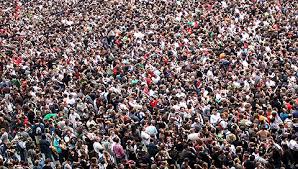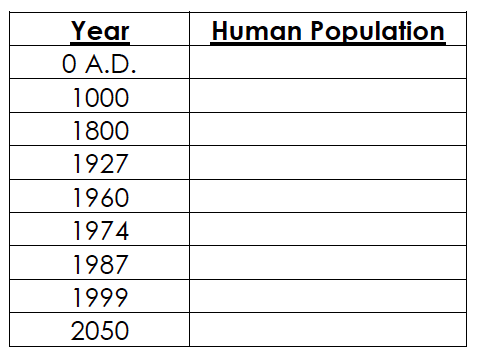Human Population WebQuest
|
Visit the following websites below and use the information found to answer the questions pertaining to that website. Each person should have their own answers on their own paper.
|
| ||||||
Population Clock:
Use the following website:
http://www.census.gov/main/www/popclock.html
What is the estimated population of the world and the United States? (0.5)
World:
US:
Human Numbers Through Time:
Click on the following website: http://www.pbs.org/wgbh/nova/worldbalance/numbers.html
Launch the Interactive (click the map on the left)
Copy the following chart on your paper and fill in the information: (2 points)
Answer the following questions about the information that you read:
1. In the 18th century what raised the living standards and spurred population growth? (0.5)
2. In the mid 1900s, what profoundly increased human life expectancy? (0.5)
3. When did the growth rate reach its all-time peak? What was the growth rate? (0.5)
4. In the 1970s, where did most of the population explosion happen? (0.5)
5. When was the 6-billionth baby born? (0.5)
6. Where will nearly all of the further human population growth take place in the world? What is a foreseeable problem with this? (0.5)
Developed vs. Developing Countries:
On the Wikipedia website, look up the following information:
7. What is a “developed” country? Characterize a developed country in terms of quality of life for the average citizen. (0.5)
8. List 2 countries that are considered “developed.” (0.5)
9. What is a “developing” country? Characterize a developing country in terms of quality of life for the average citizen. (0.5)
10. List 2 countries that are considered to be “developing.” (hint: Check out the maps on the right side of the page.) (0.5)
Global Trends Quiz:
Click on the following link http://www.pbs.org/wgbh/nova/worldbalance/trends.html
Start the quiz (click the picture of the earth)
While taking the quiz, answer the following questions.
11. What is replacement-level fertility? What is the fertility rate in European countries vs. less developed countries? (0.5)
12. What is the average life expectancy for men and women in the developed world? (0.5)
13. If the fertility rates in developing countries do not change, what will be the population in the developing world? (0.5)
14. What is the correlation between women’s education and family size? (0.5)
15. How many children under 15 are in the world? (0.5)
16. Most environmental damage caused by people in the developed world is attributable to what? (Be specific.) (0.5)
17. North Americans use how much more energy than Africans? (0.5)
18. How many cars per 1,000 people are there in China? How will this change by 2025? (0.5)
19. How many people in the world are undernourished? Where do most of the people live? (0.5)
20. What is “carrying capacity”? What is the carrying capacity for humans? (0.5)
Last, but not least:
Now, Go back to the population clock website from the beginning of the activity.
21. What is the current world population? (0.5)
22. What is the current US population? (0.5)
23. By how much did each count increase? (0.5)


